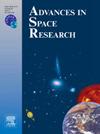自适应进入制导与时间和全状态约束使用分析阻力vs能量剖面
IF 2.8
3区 地球科学
Q2 ASTRONOMY & ASTROPHYSICS
引用次数: 0
摘要
在特定的全球运输和协同交会任务中,先进的进入飞行器需要同时满足飞行时间和全状态约束。本文主要提出了一种具有时间和终端全状态约束的自适应进入制导算法。该算法由纵向分析制导、横向制导和三自由度制导三部分组成。在纵向解析制导中,首先采用入口走廊上下边界双参数插值法,将光滑阻力加速度-能量剖面表示为5个分段多项式。推导了一种球面旋转地球上的高精度时间和距离解析预测算法,并采用双目标迭代法对剖面的双参数进行校正,以满足终端高度、速度、航迹角、距离和时间约束。其次,提出了一种基于双/单参数顺序求解模式的轮廓线在线自适应分析更新策略,提高了算法的鲁棒性;在横向部分,提出了一种基于航向调整和保持的双级自适应横向制导算法,该算法能够根据终端位置和航向角约束来规划和更新反岸序列。最后,提出了一种面向大范围航向调整的实时三维进入制导算法,实现了三维进入制导指令的在线快速生成。基于CAV-H模型的仿真结果表明,该方法能够满足所有路径约束、终端时间约束和全状态约束,对典型的进入色散具有鲁棒性,对各种进入任务具有较高的实时性。通过比较验证了该制导策略的优越性。本文章由计算机程序翻译,如有差异,请以英文原文为准。
Adaptive entry guidance with time and full state constraints using analytical drag-vs-energy profile
Advanced entry vehicles need to satisfy both flight time and full state constraints in the specific global transportation and cooperative rendezvous missions. This paper mainly proposes an adaptive entry guidance algorithm with time and terminal full state constraints. The algorithm is composed of three parts: longitudinal analytical guidance, lateral guidance and three-degree-of-freedom (3DOF) guidance. In the longitudinal analytical guidance, a smooth drag acceleration-vs-energy profile is represented as five piecewise polynomials by using the double-parameter interpolation between upper and lower boundary of entry corridor first. A high-precision analytical prediction algorithm for time and range to-go is derived over a spherical and rotating Earth, and the double-parameter of the profile can be corrected using double-objective iterative method to satisfy terminal height, velocity, flight-path angle, range, and time constraints. Secondly, an online adaptive analytical update strategy for the profile based on the double/single parameter sequential solving mode is proposed to improve the robustness of the algorithm. In the lateral part, a double-stage adaptive lateral guidance algorithm based on heading adjustment and maintaining is put forward, which is enabled to plan and update the bank-reversal sequence according to the terminal position and heading angle constraints. Finally, a real-time 3DOF entry guidance algorithm for the wide range heading adjustment is proposed to achieve the generation of the 3DOF guidance commands online rapidly. Simulations with the CAV-H model show that the presented approach is capable of satisfying all path constraints, terminal time and full state constraints, robust to typical entry dispersions, and adaptive for various entry missions with high real-time performance. The advantage of the guidance strategy is also verified by comparisons.
求助全文
通过发布文献求助,成功后即可免费获取论文全文。
去求助
来源期刊

Advances in Space Research
地学天文-地球科学综合
CiteScore
5.20
自引率
11.50%
发文量
800
审稿时长
5.8 months
期刊介绍:
The COSPAR publication Advances in Space Research (ASR) is an open journal covering all areas of space research including: space studies of the Earth''s surface, meteorology, climate, the Earth-Moon system, planets and small bodies of the solar system, upper atmospheres, ionospheres and magnetospheres of the Earth and planets including reference atmospheres, space plasmas in the solar system, astrophysics from space, materials sciences in space, fundamental physics in space, space debris, space weather, Earth observations of space phenomena, etc.
NB: Please note that manuscripts related to life sciences as related to space are no more accepted for submission to Advances in Space Research. Such manuscripts should now be submitted to the new COSPAR Journal Life Sciences in Space Research (LSSR).
All submissions are reviewed by two scientists in the field. COSPAR is an interdisciplinary scientific organization concerned with the progress of space research on an international scale. Operating under the rules of ICSU, COSPAR ignores political considerations and considers all questions solely from the scientific viewpoint.
 求助内容:
求助内容: 应助结果提醒方式:
应助结果提醒方式:


